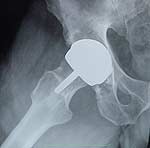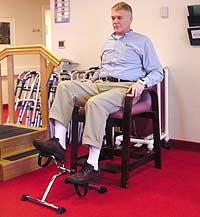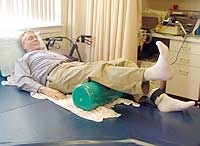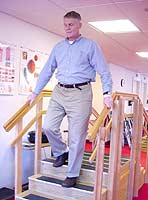Recovering From Hip Surgery:
It’s Not What I Expected
By Christopher Caile
Editor’s Note: Many aging martial
artists I know have undergone or are about to undergo hip replacement
or resurfacing. I thought it would be helpful to recount my own experience.
 |
An X-ray of my resurfaced ball joint. Looking
at it, it struck me how lucky we are to live in an age where this
type of procedure is available. In my mind flashed the image of
the T.V. series ”Six Million Dollar Man” (1974-1978)
and the phrase, “We have the technology. We can rebuild him.”
I’m still waiting for the bionics. |
On February 5th, 2008 at Englewood Hospital, just across the George
Washington Bridge from NYC where I live, I underwent a hip resurfacing
procedure (for
info on click here). It is now five weeks later.
It’s not what I expected.
My expectation was that the biggest challenge after surgery would be
getting back on my feet and then starting to walk. But I wasn’t
expecting the almost total initial muscle weakness in my operated leg
or restrictions in movement that affected everyday movement, such as putting
my pants on. I also hadn’t expected the onset of muscle tightness
now experienced. Then there was the mental confusion resulting from the
anesthesia, the powerful impact of the pain meds, or the overall loss
of strength and conditioning from my stay in the hospital and rehab. Then
there were my prohibitions.
In short, I wasn’t ready for a lot of things.
For years I had been fighting pain in my right hip. I tried a whole host
of non-invasive interventions and treatments, which seemed to provide
temporary help. I was also a teacher of Qigong (Chinese energy medicine),
so I should be able to help myself, right? But I was worried. My condition
was not improving. It was instead slowly deteriorating. I began to ask
myself what others thought when I treated them. They could see that their
healer had problems walking. Were they asking themselves how effective
I could be if I couldn’t seem to heal myself?
Then a few months ago my hip tanked. Almost overnight, it seemed, I could
no longer stretch. My kicks (I am a karate practitioner) became lower
and lower, then non-existent. Even walking became painful.
 |
In Rehab therapy, I started with simple exercises
such as cycling. |
It was time for decisive action, so I saw an orthopedic surgeon, Dr.
David Feldman, M.D. in Englewood, N.J. I knew what I wanted (I had written
on the subject) -- hip resurfacing rather than replacement. But not everyone
qualifies for this procedure.
Dr. Feldman tested, pushed and measured my mobility and then sent me
for x-rays. They showed that the ball of my femur was distorted. “It’s
a congenital condition that contributed to excessive wear,” he said.
Actually in one way I felt relieved. “After all,” I said to
myself, “I couldn’t fix this type of problem, could I? My
qigong is off the hook.”
I was told that following the operation I would be in the hospital for
a couple of days and then sent to a rehabilitation center for another
week to ten days. Some people just go home after release from the hospital
and receive in-home physical therapy. I chose a rehab center because I
wanted more intense therapy. This could be provided two to three times
daily.
Before the operation I got ready for my hospital and rehab stays. I brought
several books, a pile of magazines and some writing materials on martial
arts for an article I was writing. After all, I would have a lot of free
time.
I also prepared myself for the physical challenge. I would be up with
a walker almost immediately, I was told. I wondered about the pain? Overall,
I was confident. After all I was an athlete. My recovery would be short.
 |
There was so little strength in my leg that even
lifting up my lower leg in physical therapy was at first an effort. |
The operation starting around 9 am lasted for 2 hours. I had hoped to
have only a local anesthetic so I could be awake to take notes on my procedure,
but my doctor would have none of it. A good friend, however, a medical
doctor and chief of a medical department in the hospital was allowed to
dress and observe the operation. Periodically, he reported on my progress
to my wife in the waiting room.
I don’t remember much about my stay in the recovery room afterwards.
My wife, Jackie, said that I woke up and complained about pain.
Hours later in a hospital bed I became more awake, but was still somewhat
comatose. My karate instructor and long time friend, Kaicho Tadashi Nakamura,
and Jun Shihan Jim Baum visited. I was fading in and out, so I don’t
remember much.
In addition to pain drugs, apparently the anesthesia also affects thinking.
It makes you drowsy and distracts from mental coherency. I couldn’t
remember the names of the nurses or doctors who visited my bedside. In
my dreams I was connecting things happening around me in strange combinations.
I also remember seeing a mental slide show of various constellations in
the night sky. Now I know what so many experienced in the 1960s.
Mental confusion is typical, I was later informed.
The next morning a physical therapist arrived and helped me sit on the
edge of the bed and then stand with a walker. I felt light headed (my
blood pressure dropped) and I sat back down. But, by afternoon I was better
and was able to sit up in a wheel chair (that had a thin pad to raise
me higher off the floor).
The surprise was my right leg. I had no strength in it. It didn’t
move. I couldn’t even slide to get it over the edge of the bed.
Thus, while in bed there was only one position -- on my back with my legs
straight out. My buttocks began to ache.
My light-headedness persisted into the next few days, but pretty well
ended by the third day when I was transported by ambulance to the rehab
center.
Coherency was still elusive. Prescription medications included short
term (upon request with a minimal four hour interval) and a longer active
pain medication (twice daily), as well as assorted other drugs including
blood thinners. And during the days I sported stockings, up to my knees,
used as prevention against blood clots, sometimes a consequence of long-term
non-physical activity. My wife said they looked charming.
 |
Stairs can present a problem. You have to learn
how to walk up and down one foot at a time using the good leg first
when going up and the bad leg first when going down. Only later
can you step normally. |
By this time I had been introduced to the four no’s – things
you absolutely don’t do unless you so enjoyed your operation you
want to risk a repeat. These are really precautions so not to unduly stress
femur-hip alignment, the prosthetic implant which at this point was congealing
with the bone, and the supporting ligaments which were healing. I was
told that I would have to follow this protocol until my surgeon said it
was safe to resume regular movement,
These four restrictions were: (1) Never let the trunk of the body and
the upper thigh of the leg close to an angle less than 90 degrees (you
can’t lean forward); (2) Never cross the legs and be careful to
keep them to each side of the centerline of the body; (3) No pigeon toe
stances (don’t turn your operated leg inward so the toes angle toward
the center); (4) No rotating your body while standing on the operated
leg.
The first of these restrictions means that when you sit on a chair, or
toilet, the seat must be raised so your position doesn’t break the
90-degree angle Thus in regular chairs you sit on a thick pad and there
is also is a special extension toilet apparatus. This extension (with
handles) slides over the toilet to boost you upward.
This first restriction also means you can’t lean forward to put
on socks, underpants and pants.
To solve these mysteries at the rehab facility I received daily sessions
of Occupational Therapy. In addition to some muscle strengthening exercises,
the chief Occupational Therapist introduced me to a whole set of contraptions
that, once mastered, I ordered for home. This includes a long stiff wire
covered in cloth with a loop on the end. The loop goes over the foot of
the operated leg and like a fisherman, but with considerably more gentle
action, you haul the leg up and on board the bed. Then there is a pole
with a hoop and prong that enables you to take off your socks and push
away a pant leg. There is also a pole with a plastic jaw on one end and
a scissor-like handle on the other for picking things up that are out
of reach. And for socks there is a foot long, plastic tube cut in half
that you first pull your sock over. Then with your toe at the opening,
two ropes allow you to pull the contraption upward over your foot so the
sock slides in place – at least theoretically. I still have trouble
with this one. These contraptions were a real help since tightness in
my hip joint would have left me with no way to address the basic needs
of dressing and doing everyday chores around the house – any place
I would need to bend forward. This includes taking a shower.
Touching briefly of bathing, let me say that any hint of modesty you
ever had quickly disappears with your daily sponge bath, in your bed,
or preferably sitting on your extended toilet. Your nurse does the honors.
Mine was named Maria.
|
|
First you learn to
walk using a walker,
then using a cane. |
My physical therapy concentrated on very simple stuff. I would lie on
my back on a low wide bench and work on sliding my leg to the outside,
sliding my heel back toward my torso, and lifting my knee. The hardest
was trying to lift my leg. There were exercises too using parallel bars
like lifting the knee, shifting weight back and forth between feet, moving
my operated leg outward to one side, etc. I also peddled (a miniature
wheel), practiced walking with my walker and learned how to climb stairs.
I soon become proud of myself. My therapists had been complimenting my
progress. That evening my wife arrived with deli sandwiches and the trimmings.
We went to a public area on my floor that had a TV, couch and chairs.
There was also a round table with chairs that we could use for our dinner.
There was a woman already seated at the table. We introduced ourselves
and asked if we could join her. She kindly acquiesced. Soon afterwards
a younger man walked in with a cane. He was the son of the woman we joined,
named Kevin.
We quickly learned that Kevin had been operated on the same day as me
but had a hip replacement instead. His second, he noted. He had gone home
the day after surgery and was now back to work and driving and pretty
mobile. He was also off the serious pain meds and used only Tylenol.
“I guess I’m not doing as fabulously as I thought,”
I said to myself. My wife tried to make me feel better. “His type
of surgery may have been a little less invasive, and he probably didn’t
lose the blood that you did. And after all,” she added, “it
was his second so he knew what to prepare for and what to do.”
This didn’t help much. I still felt inadequate. She also noted
that he was younger. “Ouch.” That helped even less.
Kevin did, however, give me a preverbal “kick in the butt.”
I immediately abandoned the prescribed painkillers for Motrin. That helped
clear my mind considerably. “Why hadn’t anyone suggested that,”
I asked myself? Of course, it had been that part of my anatomy (my buttocks)
that had caused me to take the pain killers anyway. My hip only hurt minimally,
but lying on my back in the same position for over a week without being
able to shift position created a very uncomfortable feeling in my underside.
This made it difficult to fall asleep.
Soon afterwards I was reading some of the magazines I had brought. There
was also, of course, the obligatory wall TV accessible when wanted.
Kevin also prompted me to try harder, too. By now (5th day of rehab)
my walking had graduated to a cane and then I tried it without a cane.
My operated leg had also gradually gained strength. Each day there seemed
to be a little progress – small, but progress.
By the sixth day I called my wife and said “get me out of here.”
I was so tired of that bed and how my buttocks felt. The center had wanted
me to continue on for a few days (I was told that they would do that),
but had relented when I had set a date for Sunday. This was forwarded
a day to Saturday afternoon with my insistence. I needed to get out of
the hospitable bed and get home to my environment, my kids and wife.
I arrived home with the whole assortment of rehab helpers I had purchased
– a walker, cane, thick cushion, toilet seat extender, etc. -- but
by this time I wasn’t using a walker or cane. They are now in plastic
bags in the basement awaiting need from someone else.
Now, after several weeks at home, I am taking walks around the neighborhood
and doing errands daily. My walking is fine and home-visit physical therapy
has graduated to out-patient PT in a local Rehab Center three days a week.
Two weeks ago I saw surgeon, Dr. Feldman, M.D. from Englewood, NJ (who
specializes in my type of hip resurfacing). He says that the first six
to nine weeks are the most critical. This is the time that I should on
one hand be careful of what I do and how I do it (as the body adheres
to the implant and the body heals) while at the same time I strengthen
my right leg and regain my walking skills. This is reflected by my physical
therapist who says simply, ”Walk, walk and walk.”
While there I asked him how long should I continue with the protocols
(4 prohibitions). “What prohibitions?” he asked. His eyes
rolled, and he muttered something inaudible. Those apply to hip replacement,
he then said, not to your procedure. “I want you to bend over and
stretch.” He then noted that resurfacing is new and that many rehab
centers aren’t up on resurfacing protocols and just follow the protocols
for replacement. “Maybe,” he said, “they are trying
to be extra careful.”
No longer afraid to sit up a little more forward, my buttocks quickly
stopped aching.
I still have some swelling in my hip area, my right leg and hip muscles
are still a bit sore and not back to normal, but my walking is fine and
I am practicing a few slow kicks.
I am also driving and have resumed Gyrotonic, a system of movement that
stretches and strengthens muscles and tendons while exercising the joints.
Last night I assisted in teaching a karate class, although I pretty much
just stood around. It feels great to be able to move again without pain.
My whole body is smiling.
About The Author:
Christopher Caile is founder and Editor of FightingArts.com. |